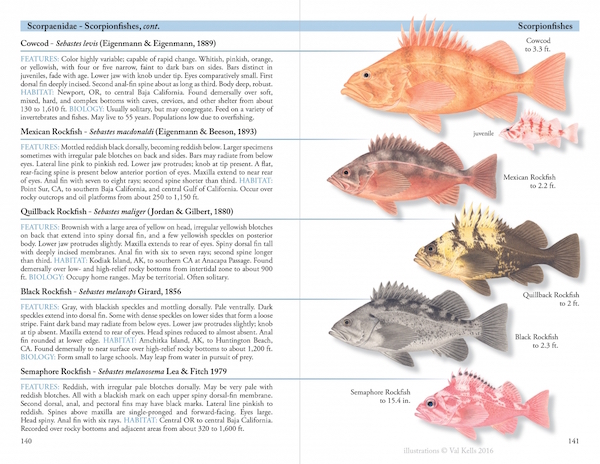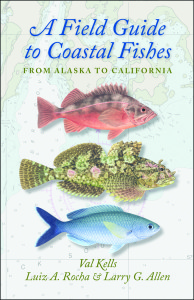Many of my fondest childhood memories involve the sea and its myriad fishes. My father was commercial fisherman. His father was a commercial fisherman. My mother worked in the offices of Bumble Bee Seafoods. Many of my aunts, uncles and cousins either caught fish or worked in fish canneries for their livings. We all lived in a small town on the Oregon coast where fishing was the trade of most of our neighbors. The mascot of my high school was even a fisherman. It would not be wrong at all to say that I grew up surrounded by fish. Which is probably why as a young naturalist the first field guide I more or less memorized was not the Peterson Field Guide to Western Birds but rather the Golden Guide to Fishes.
I would spend hour after hour pouring over the pages of that book, reading about all the fascinating creatures to be found below the waves, earnestly hoping I would once day see some of them either come over the stern of our boat in the nets or in the catches from other boats being sorted down at the docks. The now well-worn volume still holds pride of place on my bookshelves today as a reminder that regardless of how wide my natural history interests may range, they all, just as we all and everything around us did, began in the sea.
Thus when a package arrived from Johns Hopkins University Press carrying within it a copy of A Field Guide to Coastal Fishes form Alaska to California, the flashbacks came thick and fast. In no time at all I was stretched out in my favorite reading chair eagerly turning over page after page to discover what hidden undersea treasures the next one would show me. I was a nerdy nine-year-old once again and not the least bit embarrassed by it.
Written by the trio of Val Kells, Luiz A. Rocha, and Larry G. Allen, A Field Guide to Coastal Fishes from Alaska to California follows upon Kells’ widely praised 2011 published book (with coauthor Kent Carpenter) A Field Guide to Coastal Fishes from Maine to Texas and thus completes the plan for a pair of field guides illustrating and describing the fish species to be found off both coasts of the continental United States.
Using nearly 1,000 superb illustrations (more on those in a moment) in its descriptions of close to 700 different species spread over 157 taxonomic families, this new field guide is as close to comprehensive as it is reasonably possible to get for the coastal fishes of the region. While some species – primarily those with poorly documented populations or which mostly occur at depths below 660 feet – are not depicted, many of these are at least cited in their respective family sections, and whereas most fish field guides primarily focus on adults of the species, both juveniles and color variations are generously represented in this new guide as well.
Facing each page of illustrations is a concise section of relevant text presenting the biology, range, and distribution of each species depicted.

Brief overviews of all the included taxonomic families precede the individual species accounts, and a very helpful glossary, annotated list of additional rare species also sometime found in the area, bibliography, and complete index follow it. Somewhat curiously, the copy of the book I read for this review began on page 12; however it was quickly brought to my attention that the identification key intended to be printed foremost in the book had been unintentionally omitted at the printer. Thankfully, John Hopkins University Press has kindly made it available as a downloadable PDF file via their website.
But back to those exquisite illustrations. One of the challenges in depicting fish is that their patterns and coloration are evolved to best be seen underwater – while they are alive. As anyone who has spent any time around fish will readily attest, a dead fish – particularly one out of water, as would be a specimen – loses not only the complexity (subtlety, vividness, etc.) of its coloration but often aspects of its pattern as well. As a result, any photographs other than those taken underwater (which generally show colors understandably too heavily tinged with shades of blue) are ineffective in depicting living fish in all their natural beauty, and illustrations drawn from dead specimens too often fail to convey their true living image as well.
However Val Kells is not ordinary illustrator. Her ability to render piscine subjects is truly extraordinary. Each and every one of her plates included in A Field Guide to Coastal Fishes from Alaska to California is a work of art worthy of being framed and displayed in a place of honor. And as to their naturalness, I can attest to this first had after I put the guide to a test at the Shaw Centre for the Salish Sea, where I spend a considerable amount of time comparing the living specimens on display there to Kells’ illustrations in the book. Each and every time the illustration brilliantly depicted the living specimen before me to which I was comparing it. Indeed, I highly recommend taking a copy of the book along on any aquarium visit (particularly those featuring a large collection of Pacific coast species) for the additional insight it can provide about what is being seen.
Almost needless to state at this point, I heartily recommend A Field Guide to Coastal Fishes from Alaska to California to any and all with an interest in the fish of the region, from naturalists and fishermen to students and the simply curious (and even to sushi connoisseurs as well – if for no other reason than to clearly understand the differences between Escolar and the more gastronomically troublesome Snake Mackerel). It is not only and exceptionally informative and endlessly interesting book, it is also a remarkably relaxing one that can be leisurely perused and enjoyed for the sheer beauty of the illustrations it contains.
 Title: A Field Guide to Coastal Fishes From Alaska to California
Title: A Field Guide to Coastal Fishes From Alaska to California
Author: Val Kells, Luiz A. Rocha, and Larry G. Allen
Publisher: Johns Hopkins University Press
Format: Paperback
Pages: 376 pp., 996 color illus.
ISBN: 9781421418322
Published: January 2016
In accordance with Federal Trade Commission 16 CFR Part 255, it is disclosed that the copy of the book read in order to produce this review was provided gratis to the reviewer by the publisher.
If you enjoyed reading this, please consider signing up for The Well-read Naturalist's newsletter. You'll receive a helpful list of recently published reviews, short essays, and notes about books in your e-mail inbox once each fortnight.
